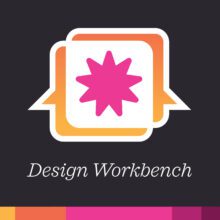Why is human-centered design not enough? I explore human-centered design, activity-centered design, and people-driven design.


Episode Transcript
People-driven design. Why is human-centered design not enough? Now on design workbench.
This is design workbench and I am Dennis Cheatham, a design educator, and researcher at Miami University in Oxford, Ohio. I am also the graduate director of xdMFA, the MFA in Experience Design here at Miami.
In this podcast, I demystify concepts within design, research, design, thinking, and design making, all in service of experience design, which is a holistic approach to designing that considers the whole person and endeavors to create products, services, and systems, that create experiences people want to repeat. This idea of experience design holds that people will choose a product service or system, not because it helps them do something, but because the experience that it produces for them is the differentiating factor. To design for experiences, designers must go beyond being experts at color, usability, or button sizes. Rather, they must be expert researchers and expert makers that consider people’s entire experiences.
So that’s enough about experience design. For now, I’m not going to do this every show, I promise, let’s get into our topic.
The words we use can drastically impact our understanding of the world around us, including design, what’s in a name after all? Well, in this episode, I’m talking about three different approaches to design, human-centered design, activity-centered design, and people-driven design.
Human-Centered Design is about how it sounds, it places a human at the center of the design process, they are the whole reason why we design best we can tell human-centered design gained popularity as a term in the 1960s, where designers began considering who is the person we’re designing for, what is their makeup? And when we consider that makeup, like the size of their hands when they’re using a mixer to make pudding or a cake, then how can we make that design to best match their dimensions? Human-Centered Design also expands into empathy. What are people feeling? What are their needs, when we consider their life situation, and other aspects like that.
Human-Centered Design places the human as the driver for design. Now, designers sometimes make design because it’s something cool or something they want to make. You may even have an example of this, where you’ve designed a poster or an app or a service. And I thought—this is gonna be really cool. And I’m so excited to use this typeface. And these colors are going to be amazing. That’s a little bit more like designer-centered design, and maybe not human-centered design. Notice how the words reframe your thinking about who the design is for and what it’s trying to do. When we use different words, it focuses our minds on what we’re designing and why we’re designing. And the outcomes can be drastically different when we use different words.
Activity-centered design is an idea that when people use design, they don’t necessarily think I want to use a chair or I’m excited about doing this service for voting. They’re really trying to do something, there’s an activity they’re trying to complete. So when someone uses a chair, they’re not thinking, I want a chair, they’re thinking I want to sit, the activity is sitting. Now granted, not all sitting activities are the same. Sometimes I can sit down in a really cushy chair and I’m thinking I want to sit here for a long time and I want to relax. That’s the kind of sitting activity I’m interested in so I can read a book. There are other sitting times for example on a stool when I want to sit for a short amount of time and then I need to move on. In both of these cases, the activity is sitting, I want to sit.
So, activity-centered design focuses us on the fact that people use design to do stuff, they want to complete activities. Notice how that kind of framing may drastically impact how we create? If I do design research, and I learn about a person and the activity they’re trying to do, then the thing I make, will need to cater to that activity to help them get it done. If someone’s ordering a coffee, I can design a service, they walk through the door, they look up the menu board, they speak with an employee, they pay, they wait for their coffee, see all these steps. Design is at every step, this is service design. During those steps, the activity is always “I want to order a coffee and drink a coffee”. But what we design in there, the sound and the restaurant, or how you wait in line, and how big the type is on the menu board all support the activity.
If the music has got a really nice feel and makes me feel like it’s a place that I want to be, my experience will be better. Now we’re getting into experience design, and that overall feeling in the store. But regardless, we’re all about an activity with this service. The activity is I want to drink a coffee, and I need to buy one. When I started thinking carefully about design and how people use it. Human-Centered Design felt way too small and particular, people are more than just biological units called “human.” There’s more to people than just that physical makeup. So activity center design helped me to better understand that when we think about what people do, there’s motivation and attitudes and all of that that comes into the activity. However, people-driven design is a term that I came up with that better encapsulates both that human and the activity.
Here’s how people-driven design says that people should be the drivers of what we create, that they should be involved in the process. co-creation and participatory design are both concepts where people have a say that they should be part of the designing process. Or that as we do design research, we should be very careful to take into account what we learn about people’s cultural backgrounds, their needs, where they come from, and their attitudes as part of the designing process. So there’s that driven word right there.
People understands that people are cultural, people are relational, that a person who has a child may make different decisions than somebody who doesn’t. I know, as a parent myself, a lot of times I will choose different products and services, just because I’m looking out for my kids aren’t considering their development. If I did not have children, then I probably make different choices. So people—that word says that people are relational people are cultural, they have fears and needs. They’re highly complex.
So people-driven design is a container that wraps around human-centered and activity-centered design, but puts people as active participants in what we design and recommend and, and recognizes that those people have different motives and priorities. Sometimes those are their pets. Sometimes people are driven to say we should save the environment. In these cases, we may even be designing for something other than people who may be designing for environment and sustainability. But those are driven by the people’s values.
People-driven design is a pathway to experience design, where we’re considering people’s emotional feelings, their physical feelings when they use design, and then also our ability to use things like sound, or messaging, or story to create a design that feels personal, specially made for that person who’s using it. For example, a hospital service where an individual’s emotional fears or their concerns are actually cared for as well as their physical healing and well-being.
I’ll talk more about how we can design experiences in future episodes, and specifically how we can use things like color, sound, and other design approaches to make services, products, and systems that people love. Every episode, I’ll leave you with a parting question, a question that will spark your thinking about design, research, design, thinking, and design making to grow your practice and your understanding of design and experiences.
Think with me now about something you’re designing or have designed in the past. If it’s a print-based design, it might be a brochure or a billboard. If it’s screen-based, perhaps it’s a web ad or an app. Think about that design’s features. What colors did you use? What were the type sizes? Did you design it? So people could interact with it online? When they tapped on a touchscreen? Did a drawer open to reveal text? Or was video embedded into a page? Things like this. Think about these features. What drove your decisions to put these features into place? Was it because you thought it would be cool? Or did you consider the people?
Was this a human-centered design that empathized or was there features that met a person’s physical makeup? Was it activity-centered design, where it really considered what the person was trying to do with what you made? Or maybe it was people-driven, where you were considering their emotional state and other complex factors that shaped your design. I imagine you got features in there that were built based on what you wanted to do what you thought would be cool. I only say this because I’ve totally done that myself.
What are ways you can make your design so they’re more people-driven? We’ll talk about that again in future episodes. But ask yourself these questions and see how your design will change when you use different words and reframe your thinking.
That’s it for this first episode of design workbench. Thanks for listening along and have a great day.
References
Design Kit. (n.d.). What is Human-Centered Design? https://www.designkit.org/human-centered-design
Norman, D. (2005). Human-Centered Design Considered Harmful. Interactions, 12(4), 14-19. http://jnd.org/dn.mss/human-centered_design_considered_harmful.html
Norman, D. (2008). HCD Harmful? A Clarification. https://jnd.org/hcd_harmful_a_clarification/